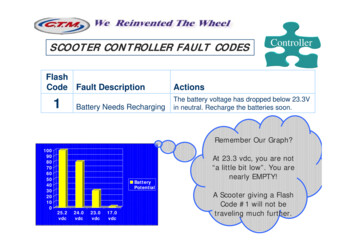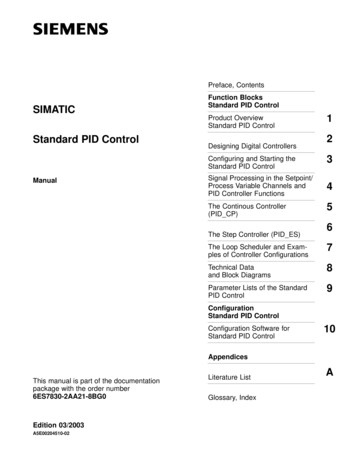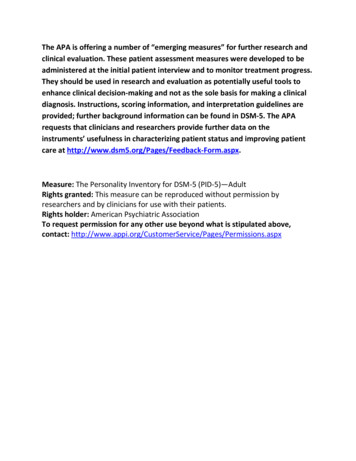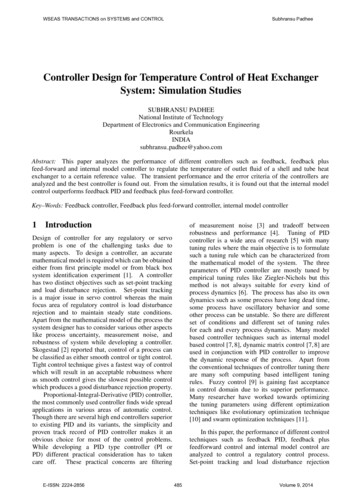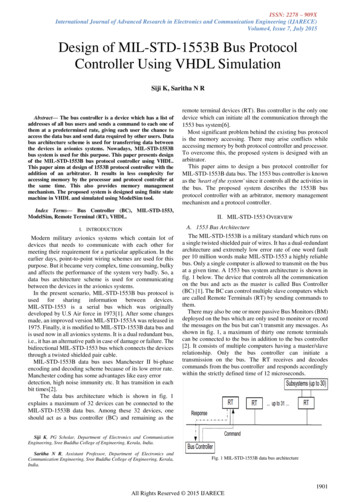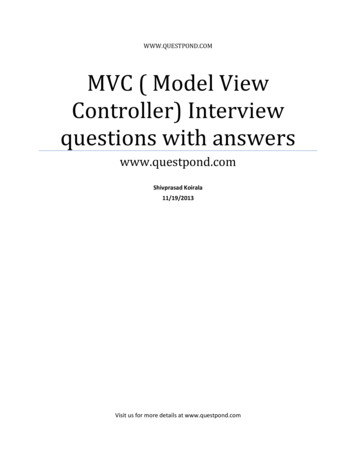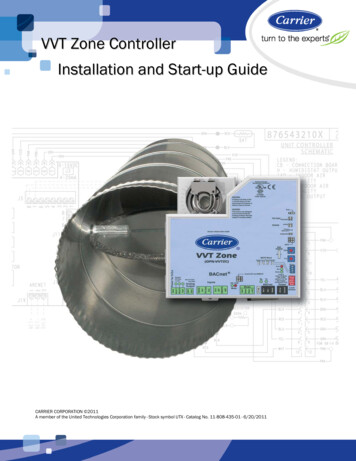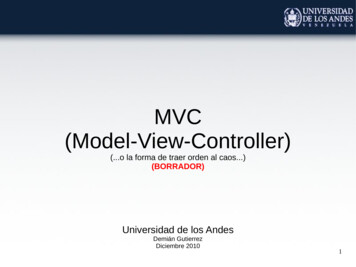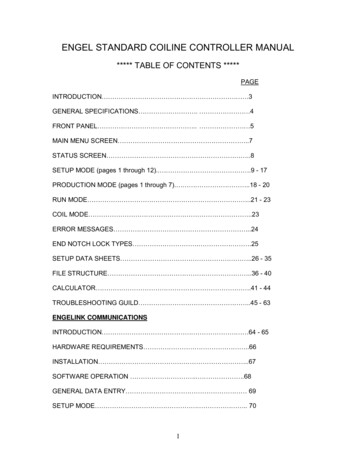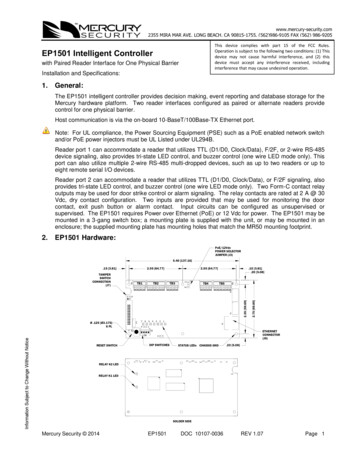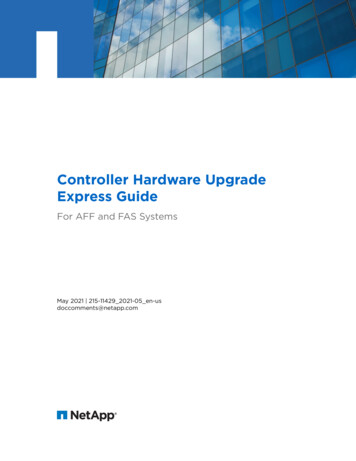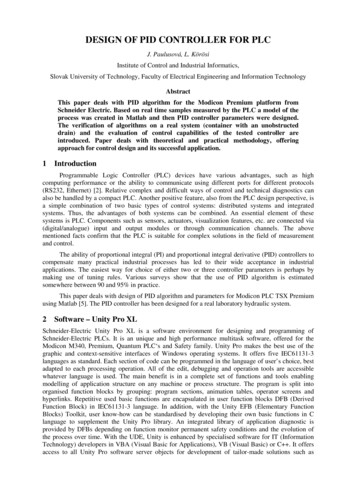
Transcription
DESIGN OF PID CONTROLLER FOR PLCJ. Paulusová, L. KörösiInstitute of Control and Industrial Informatics,Slovak University of Technology, Faculty of Electrical Engineering and Information TechnologyAbstractThis paper deals with PID algorithm for the Modicon Premium platform fromSchneider Electric. Based on real time samples measured by the PLC a model of theprocess was created in Matlab and then PID controller parameters were designed.The verification of algorithms on a real system (container with an unobstructeddrain) and the evaluation of control capabilities of the tested controller areintroduced. Paper deals with theoretical and practical methodology, offeringapproach for control design and its successful application.1IntroductionProgrammable Logic Controller (PLC) devices have various advantages, such as highcomputing performance or the ability to communicate using different ports for different protocols(RS232, Ethernet) [2]. Relative complex and difficult ways of control and technical diagnostics canalso be handled by a compact PLC. Another positive feature, also from the PLC design perspective, isa simple combination of two basic types of control systems: distributed systems and integratedsystems. Thus, the advantages of both systems can be combined. An essential element of thesesystems is PLC. Components such as sensors, actuators, visualization features, etc. are connected via(digital/analogue) input and output modules or through communication channels. The abovementioned facts confirm that the PLC is suitable for complex solutions in the field of measurementand control.The ability of proportional integral (PI) and proportional integral derivative (PID) controllers tocompensate many practical industrial processes has led to their wide acceptance in industrialapplications. The easiest way for choice of either two or three controller parameters is perhaps bymaking use of tuning rules. Various surveys show that the use of PID algorithm is estimatedsomewhere between 90 and 95% in practice.This paper deals with design of PID algorithm and parameters for Modicon PLC TSX Premiumusing Matlab [5]. The PID controller has been designed for a real laboratory hydraulic system.2Software – Unity Pro XLSchneider-Electric Unity Pro XL is a software environment for designing and programming ofSchneider-Electric PLCs. It is an unique and high performance multitask software, offered for theModicon M340, Premium, Quantum PLC‘s and Safety family. Unity Pro makes the best use of thegraphic and context-sensitive interfaces of Windows operating systems. It offers five IEC61131-3languages as standard. Each section of code can be programmed in the language of user’s choice, bestadapted to each processing operation. All of the edit, debugging and operation tools are accessiblewhatever language is used. The main benefit is in a complete set of functions and tools enablingmodelling of application structure on any machine or process structure. The program is split intoorganised function blocks by grouping: program sections, animation tables, operator screens andhyperlinks. Repetitive used basic functions are encapsulated in user function blocks DFB (DerivedFunction Block) in IEC61131-3 language. In addition, with the Unity EFB (Elementary FunctionBlocks) Toolkit, user know-how can be standardised by developing their own basic functions in Clanguage to supplement the Unity Pro library. An integrated library of application diagnostic isprovided by DFBs depending on function monitor permanent safety conditions and the evolution ofthe process over time. With the UDE, Unity is enhanced by specialised software for IT (InformationTechnology) developers in VBA (Visual Basic for Applications), VB (Visual Basic) or C . It offersaccess to all Unity Pro software server objects for development of tailor-made solutions such as
creation of interfaces with an electrical CAD (Computer-Aided Design) or application automaticgenerator. Example of Unity Pro application is in Fig. 1.Figure 1: An example of Unity Pro application3PID controller designPID control is a fundamental feedback control mechanism for various systems. It attempts tocorrect the difference between the measured and desired value – control error – using manipulatedvariable to suppress this difference to zero. The controller is represented by three components:proportional – represents the controller gain, depending on the error determines the actual response;integral – performs the sum of past deviations and derivative component – works with the rate ofchange of the error.Different PID function blocks are used in Unity Pro. These function blocks performinitialization in the first program cycle of the PLC program. Therefore they must be called in the mainprogram task, otherwise the initialization fails and outputs can have bad values [1].These function blocks have the following properties:- calculating the proportional, integral and differential component in its incremental form,- anti-windup reset,- direct or inverse action,- differential component to process value or deviation,- parameterization of the differential component transfer gain,- weight of the setpoint in the proportional component (reducing the overrun),- feed forward component for disturbance compensation,- dead zone on deviation,- incremental value and absolute value output,- upper and lower limit on the output signal (according to operating mode),- gradient limitation of the output signal,- output offset,- selecting manual/automatic mode,- tracking mode - bump less changeover between manual and automatic,- upper and lower setpoint limit.General block diagram of the PID function is shown in Fig. 2.
AutotuningSetpointProcessingsetpointProcess valueFeed forwardLoopcontroller andcommandprocessingProcessingProcess valueAutoProcessingOutputManualProcessingFeed ForwardManual commandTrackingFigure 2: PID function block diagramRepresentation of the PID function block (in Function Block Diagram - FBD language) withinputs and outputs is shown in Fig. 3. The illustration shows, that it is possible to assign SP, PV,MODE PARA FEED FWD a YMAN tags (variables). Variables are explained in detail in Table 1.Figure 3: PID Function blockPossibility to create controllers with different combinations of P, I and D components isprovided by Boolean internal variables of the functional block en p, en i a en d by setting theirvalues to 0 or 1.Table 1: LIST AND DESCRIPTION OF PID CONTROLLER rameterData typeDescriptionSPREALReference valuePVREALProcess valueMODEMode PIDOperating modePARAPara PIDParametersFEED FWDREALFeed forwardYMANREALController output valuein manual modeYREALManipulated variableERRREALControl deviationSTATUSStat MAXMINState of manipulatedvariable
The structure and description of the data types of variables Mode PID, Para PIDand Stat MAXMIN are in Tab. 2.Table 2: LIST AND DESCRIPTION OF DATA STRUCTURES PID CONTROLLERStructureMode PIDPara PIDParameterDatatypemanBOOL"1": Manual modehaltBOOL"1": Halt modeen pBOOL"1": P enableden iBOOL"1": I enableden dBOOL"1": D enabledd on pvBOOL"1": D processing deviation, "0": Dprocessing process valuegainREALGaintiTIMEIntegral timetdTIMEDerivation timetd lagTIMEDelay of DymaxREALUpper limit of manipulated variableyminREALLower limit of manipulatedvariableqmaxBOOLUpper limit of manipulated variablereachedqminBOOLLower limit of manipulatedvariable reachedStat MAXMIN4DescriptionCase studyHydraulic system (Fig. 4) consists of water tank with water reservoir, PLC, pressure transmitter,frequency inverter and a pump [3].Honeywell ST 3000 S900 pressure transmitter was used to measure the water level in the tank.It is a reliable and intelligent transmitter [4]. It offers the possibility of measuring pressure, absolutepressure, differential pressure and level. The signal from the transmitter is connected to the PLCanalogue input card.The transfer of water from the water reservoir into the water tank was making use of amonoblock centrifugal pump with threaded neck from CALPEDA manufacturer. The pump type isCALPEDA NM 2/AE.The pump is controlled by a compact inverter PowerFlex 40 from Allen-Bradley, which isconnected to the PLC analogue output card.PowerFlex 40 has a standard control panel display, touch keypad and potentiometer. Theinverter also includes LEDs to indicate the current status of the inverter.
Figure 4: Block diagram of the hydraulic system (PLC, inverter, pump, pressure transmitter, tank andreservoir)5Simulation ResultsThe Kp, Ti and Td parameters has been obtained by Ziegler-Nichols method [6].Transfer function of PID controller is:G R (s ) U (s )I1 P Ds K p 1 Td s E (s )s Ti s The procedure is as follows:1) Turn off the I-term and the D-term in the controller.2) Turn P to zero, and then increase it slowly, while looking at time responses of the output variable(y) or - some times better - the output of the controller, u. Increase P until the output exhibits sustainedoscillations (see Fig. 5 - violet, P 6.5)3) At this "quasi steady-state" point we have reached the critical gain, called P PK, and period ofoscillations, TK 5.34 s.4) Then the Ti and Td should be turned on with the following configuration values (see the Tab. 3).Figure 5: Time responses of the output variable by different parameter P (I 0, D 0)(1)
Table 3: CLOSED-LOOP CALCULATIONS OF PID PARAMETERSKpTiTdP controllerPK / 2--PI controllerPK / 2.2TK / 1.2-PID controllerPK / 2.7TK / 2TK / 8From Tab. 3, Kp, Ti, and Td can be calculated for all three types of controllers. The results areshown in (Tab. 4 and Tab. 5).Table 4: PARAMETERS OF PID CONTROLLER (SEE EQ. 1)KpTiTdP controller3.25--PI controller2.954.45-PID controller3.822.670.67TABLE 5: PARAMETERS OF PID CONTROLLER (SEE EQ. 1)PIDP controller3.25--PI controller2.950.66-PID controller3.821.432.55At first glance, we can see from the table that the PI controller has Ti greater than Kp, and intheory we know that for the most applications it is the opposite.Also Td is high value in comparison with the other parameters and such tuned PID controller cancreate oscillations of the output variable around the desired variable.Figure 6: Time responses of the output variable under PID controller (Ziegler-Nichols method)
Time responses of the output variable under Ziegler-Nichols controller are shown in Fig. 6.Designed PI controller (Ziegler-Nichols) is compared with PI controller, whose parameters weredesigned by experimental methods (P 2.6, I 3.6). Time responses of the output variable under bothcontrollers are shown in Fig. 7.Figure 7: Comparison of time responses of the output variable under PI controller (Ziegler-Nicholsmethod and experimental method)6ConclusionThis paper deals with control of a real system – a container with an unobstructed drain. PIDcontroller for control of hydraulic system was designed by Ziegler-Nichols method and experimentalmethod. Each of the designed control loops were verified by a simulation model in Matlab-Simulinkbefore a test on the real system.ACKNOWLEDGMENTThis paper was supported by the Slovak Scientific Grant Agency VEGA, Grant no. 1/1105/12,Grant No. 1/2256/12 and Grant No. 1/1241/12.References[1] A. Pulen. Implementation of automatic design of PID controller in the PLC. Master Thesis, FEISTU, Slovak Republic, May 2009.[2] L. Mrafko, M. Mrosko, L. Körösi: PLC a ich programovanie. Available on internet: http://www.posterus.sk/?p 6903 [3] : http://www.controltech.sk/products/fmpf40.php?pid 2 [4] Inteligentný vysielač pretlaku, absolútneho tlaku, tlakovej diferencie a hladiny ST 3000. Availableon internet: http://www.honeywell.sk/?com documents&node 341&id 672 [5] ModiconTSXPremiumPLCs.Availableoninternet: ls/PLCProces.pdf
[6] Štruktúry a formy spojitých PID regulátorov. Available on internet: /Linearne%20systemy%20 2005/ls1prednaska.pdf Jana Paulusová and Ladislav KörösiInstitute of Control and Industrial Informatics,Faculty of Electrical Engineering and Information Technology,Slovak University of Technology,Ilkovičova 3, 812 19 Bratislava, Slovak Republice-mail: jana.paulusova@stuba.sk, ladislav.korosi@stuba.sk
generator. Example of Unity Pro application is in Fig. 1. Figure 1: An example of Unity Pro application 3 PID controller design PID control is a fundamental feedback control mechanism for various systems. It attempts to correct the difference between the measured and desired value – File Size: 662KBPage Count: 8

